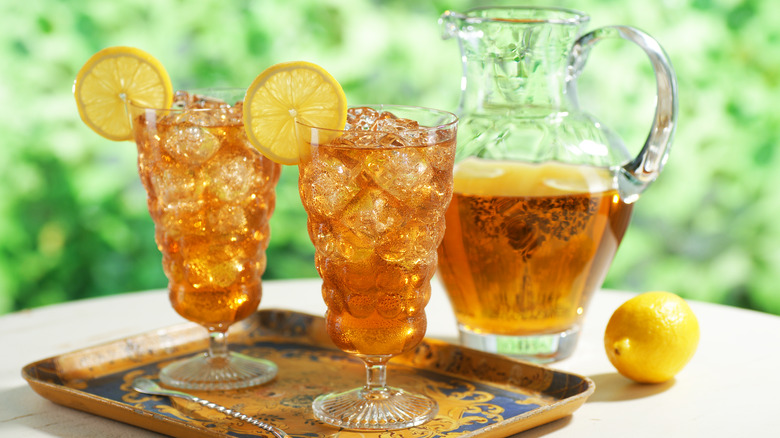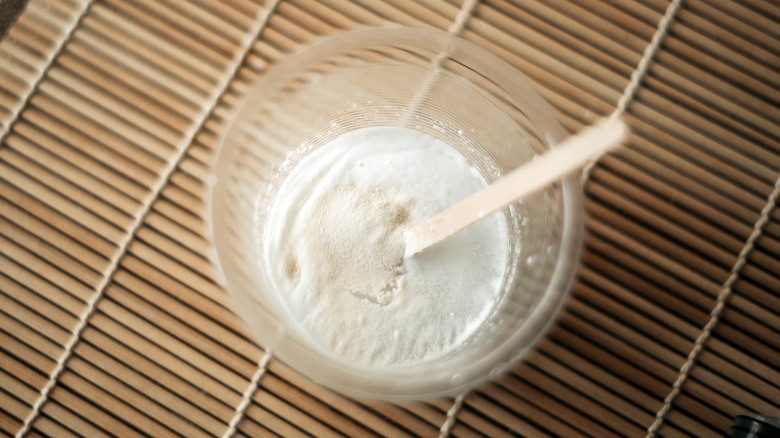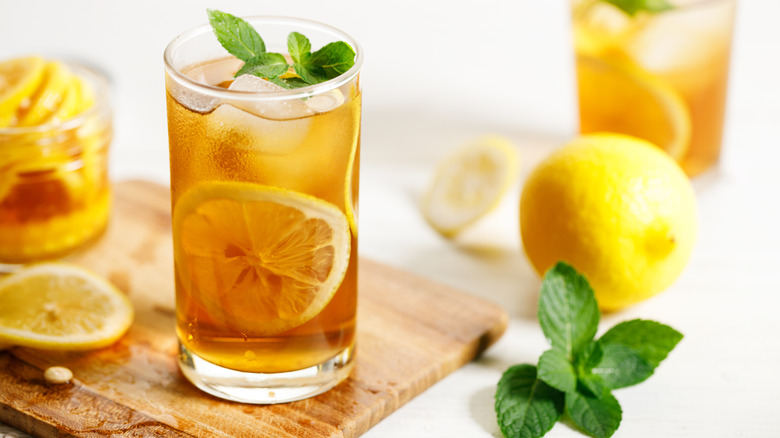Baking Soda Is The Ultimate Secret Ingredient For Better Iced Tea
Although it's widely enjoyed in the United States, tea is unequivocally linked to Britain, unless, of course, the tea is iced. It's as rare in the U.K. as it is plentiful in the American South. Southerners drink it by the gallons, not just in the steamy summertime, but all year round. There are tons of ways to make excellent iced tea, but the addition of baking soda may take some by surprise.
Adding a pinch of baking soda to a pitcher of iced tea can help balance any bitterness present from the tea leaves and remove the cloudiness in the beverage, resulting in a crystal-clear concoction. Because it only takes a bit (no more than ⅛ teaspoon) of baking soda to achieve this effect, you won't be able to taste anything other than the icy tea and whatever flavorings you might add, from sugar to fresh peaches, lemon slices, and mint.
Tea and baking soda have great chemistry
If you've ever taken a sip of black or green tea and immediately felt like your mouth or tongue was dry, then you've experienced the phenomenon of tannins. Present in things like red wine, tea, and coffee, tannins are naturally occurring polyphenols that impart a bitter taste. The longer tea is brewed, the stronger the tannins become, giving the tea a flavor that some might describe as sour or acidic. Because baking soda is an alkaline, it balances out the bitterness of the tea's acidity. This all comes down to the pH scale.
The pH scale measures how acidic a substance is; the lower the number, the higher its acidity. Pure water has a pH of seven, and is considered neutral. Anything lower than seven is acidic, while anything higher is alkaline. Black tea (which is often used for iced tea) has an average pH level of 4.9 to 5.5. The pH of baking soda is 9.5, and when combined with tea, it softens the acid, making the drink taste smoother.
It turns out those pesky tannins also cause tea to appear cloudy. Tannins dissolve in hot water, but when they are chilled quickly, they bind with the caffeine and cause an unfiltered look. A bit of baking soda binds with the tannins and prevents them from reacting adversely when chilled, helping to retain clarity.
More tips for better iced tea
Some iced tea purists may argue that baking soda has no business in iced tea, and that if you take proper steps to ensure your tea is smooth and clear while making it, there is no need for sodium bicarbonate. Whichever camp you're in, it's always good to know how to make the best iced tea possible. Obviously, it all starts with the type of tea you brew. You can make iced tea from any type of tea leaves, but for the classic, traditional flavor of Southern iced tea, use a black tea specifically blended for iced tea use. Brands like Lipton and Luzianne make iced tea brew bags.
If you're using regular iced tea bags (as opposed to ones specifically made to be brewed with cold water), you'll need filtered, hot water to brew, but be careful not to steep your bags in water that is actively boiling, as excessively hot temperatures will make the tea taste bitter. The ideal temperature for brewing is between 200 and 212 degrees Fahrenheit, and surprisingly, you don't need to leave the tea bags in for long — brew for five minutes maximum to prevent excessive bitterness. Of course, if you accidentally oversteep, add in that pinch of baking soda.
If you're using sugar, add and combine it with the tea while it's still warm so it will thoroughly dissolve, and bring your container or pitcher to room temperature before chilling it in the fridge.



